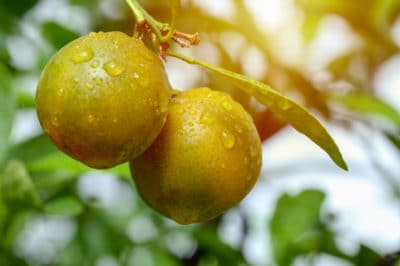Orange Ripening by Variety
Every sweet orange tree (Citrus sinensis) blooms sometime in spring. Depending on variety, however, its fruit takes from seven to 10 months to ripen and stops getting sweeter once picked. So knowing what kind of orange you have is essential to avoiding a premature harvest.
Picking times for the most commonly grown sweet oranges are:
- April through October: Valencias
- November through May: Navels
- October through January: Hamlins
- February through April: Pineapple oranges — Valencia and Hamlin hybrids.
- December through May:Blood oranges, depending on cultivar. ‘Moro’ ripens in early December, ‘Tarocco’ in mid-December and ‘Sanguinello’ in February.
Expert gardener’s tip: Ripe Valencias and navels keep on the tree for up to six months but other varieties become bitter if left that long without harvesting.
Reading the Signs
While we’re all accustomed to the golden-orange fruit in our grocery stores, a sunny rind does not a ripe orange make. Oranges get their green color from chlorophyll that masks their orange pigments. If cold weather doesn’t remove the chlorophyll, ripe oranges stay green on the outside while being sweet and juicy on the inside.
As subtropicals, sweet orange trees grow in USDA plant hardiness zones 9 through 11. Cold winters aren’t a given, so don’t count on your oranges’ rinds to tell you when they’re ripe.
Instead, choose two likely fruits from opposite sides of the tree. They should feel heavy and firm, with the right size for ripe oranges of their variety. If they’re ready, their stems will pull away from their branches without resisting. But the final test is to slice them open for a sample.
If you’re satisfied with their sweetness and juiciness, eating season has arrived. Expect the rest of the crop to continue ripening at its own pace and pick the individual oranges when they’re ready.
Expert gardener’s tip: If your oranges have thick peels, just twist them from the branches by hand. Thin-peeled fruit bruises easily, so it’s best to harvest it with clippers.
